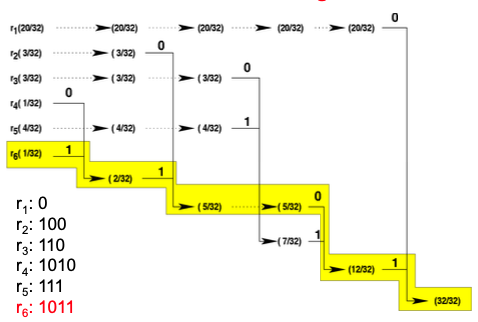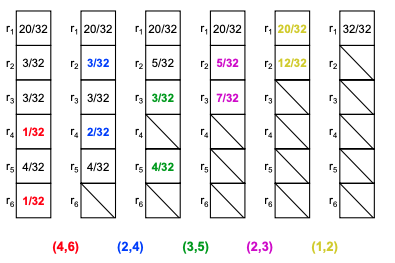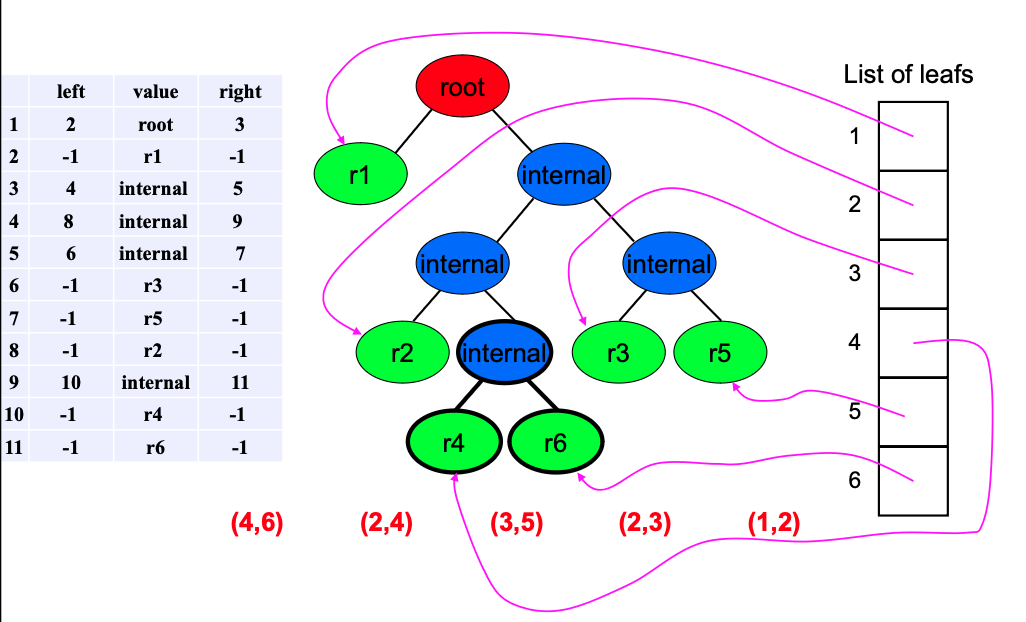Huffman Coding
Codeword Encoding/Decoding
- Encoding involves assigning binary sequences to elements of an alphabet.
- An alphabet is a collection of symbols.
- The set of binary sequences is known as a code or codebook.
- Each sequence in the code is referred to as a codeword.
- Example: ASCII uses a fixed-length 7-bit code, where ‘a’ is coded as
11000012 and ‘A’ as10000012.
Fixed-Length Codes
- The simplest method of encoding, where each codeword has the same number of bits.
- This method’s bit rate per symbol is consistent, equivalent to the codeword length.
- To reduce bits required for various messages, a variable bit length per symbol can be used, especially to use fewer bits for more frequently occurring symbols.
Codeword Decoding
- Decoding converts a codeword back to the corresponding element in the alphabet.
- A uniquely decodable code means there is only one way to decode a sequence of codewords.
- Non-uniquely Decodable Example: The phrase “I saw a man on a hill with a telescope” can imply multiple interpretations.
Uniquely Decodable Codes
Example 1
- Codewords: a1 → 0, a2 → 0, a3 → 1, a4 → 10
- This code is not uniquely decodable as a1 and a2 share the same codeword, causing ambiguity.
Example 2
- Codewords: a1 → 0, a2 → 1, a3 → 00, a4 → 11
- Ambiguity arises here because encoding a1 twice (
00) can also decode as a3.
Example 3
- Codewords: a1 → 0, a2 → 10, a3 → 110, a4 → 111
- This is a uniquely decodable and instantaneous code because each codeword’s end can be identified without extra context (ends with
0or three consecutive1s).
Example 4
- Codewords: a1 → 0, a2 → 01, a3 → 011, a4 → 0111
- Also uniquely decodable; decoding stops as soon as a
0is encountered. - However, it lacks the instantaneous property of Example 3 because the decoder needs to check following bits to confirm codeword completion.
Discussion on Instantaneous Codes
- Instantaneous codes allow immediate decoding of each codeword as it is read, without needing the subsequent codeword.
- While beneficial, instantaneous decoding is not required for a code to be uniquely decodable.
Definitions and Testing for Unique Decodability
- Prefixes and Dangling Suffixes: A codeword
a(k bits long) is considered a prefix of another codewordb(n bits long, where k < n) if the first k bits ofbare identical toa. The remaining bits ofbare called the dangling suffix. - Example: If
a = 010andb = 01011, thenais a prefix ofb, and the dangling suffix is11.
Procedure to Test for Unique Decodability
- Examine all pairs of codewords: Identify if one codeword is a prefix of another.
- Check the dangling suffix: If the dangling suffix matches any original codeword, the code is not uniquely decodable. Otherwise, add the dangling suffix to an augmented list for further checks.
- Repeat the process: Continue until no new unique dangling suffixes can be added or a suffix matches an original codeword.
Examples
Example 5
- Codewords:
a1 → 0,a2 → 01,a3 → 11 - Analysis:
- Initial list:
{0, 01, 11} 0is a prefix for01with dangling suffix1.- The list becomes
{0, 01, 11, 1}. - No further unique suffixes, and no suffix matches a codeword exactly. Hence, the code is uniquely decodable.
- Initial list:
Example 6
- Codewords:
a1 → 0,a2 → 01,a3 → 10 - Analysis:
- Initial list:
{0, 01, 10} 0is a prefix for01with dangling suffix1.1is a prefix for10with dangling suffix0.- Since
0is a codeword, the code is not uniquely decodable. - Counter Example: Concatenation of
01and10can be decoded ambiguously asa2 a1ora1 a3.
- Initial list:
Example 7
- Codewords:
a1 → 101,a2 → 1011,a3 → 0100,a4 → 00101 - Analysis:
- Identifying prefixes and suffixes creates a cycle where
101(a1) reappears as a suffix, confirming the code is not uniquely decodable. - Counter Example: The sequence
10110100101can be decoded in multiple ways, confirming ambiguity.
- Identifying prefixes and suffixes creates a cycle where
Notes on Uniquely Decodable Codes
- NB1: This testing method does not assess whether the code is instantaneous.
- NB2: If no codeword is a prefix of another, this results in a prefix-free code. Prefix-free codes are always uniquely decodable and instantaneous, but not all uniquely decodable codes are prefix-free.
Huffman Encoding
A full implementation can be seen here
- Node Layout: Begin by laying out the individual symbols as an array of unmarked nodes.
- Weight Assignment: Assign to each node a weight corresponding to the frequency or probability of the symbol’s occurrence.
- Tree Construction:
- Identify two unmarked nodes with the lowest weights.
- Create an unmarked parent node for these two nodes, assigning it a weight equal to the sum of the weights of the two child nodes.
- Label the paths to the child nodes arbitrarily with “0” and “1”.
- Mark the child nodes as part of the tree.
- Code Generation: The code for each symbol is formed by accumulating the labels from the root to the symbol itself at the leaf.
Example of Huffman Encoding
Consider a set of symbols R = {r1, r2, r3, r4, r5, r6} with the following probabilities of occurrence:
- P(r1) = 20/32
- P(r2) = 3/32
- P(r3) = 3/32
- P(r4) = 1/32
- P(r5) = 4/32
- P(r6) = 1/32


Draw Huffman trees
- Start from a single node (the root node).
- Each node can have either:
- zero branch (in this case we call it external node, or leave node)
- Two branches (in this case we call it internal node)
- One of these branches corresponds to a 0 (assume it is the left branch).
- The other branch corresponds to 1 (assume it is the right branch).

While the end-of-symbols-need-to-be-encoded is not reached:
- Read a single symbol from the input data.
- Find the corresponding Huffman code for that symbol.
- Concatenate this Huffman code to the compressed Huffman data.
Example:
r5 r1 r1 r5 r2 r6 r3 r1 r1 r4will be encoded as111001111001011110001010.
Consider a set of symbols R = {r1, r2, r3, r4}
- The probability of occurrence of these symbols are:
- P(r1) = 1/8
- P(r2) = 1/8
- P(r3) = 1/4
- P(r4) = 1/2
Design a Huffman code for these symbols and calculate the average bit rate per each symbol.
-
Using the same steps in Figure 1,
- r1: 100
- r2: 101
- r3: 11
- r4: 0
Average bit rate calculation:
-
3 × 1/8 + 3 × 1/8 + 2 × 1/4 + 1 × 1/2 = 1.75 bits per symbol - Consider a set of symbols R = {r1, r2, r3, r4}
- The probability of occurrence of these symbols are:
- P(r1) = 1/4
- P(r2) = 1/4
- P(r3) = 1/4
- P(r4) = 1/4
- Design a Huffman code for these symbols and calculate the average bit rate per each symbol.
Assigned Huffman Codes:
- r1: 00
- r2: 01
- r3: 10
- r4: 11
Average bit rate calculation:
2 × 1/4 + 2 × 1/4 + 2 × 1/4 + 2 × 1/4 = 2 bits per symbol
Huffman Decoding
While the end-of-compressed-Huffman-data is not reached:
- Set the current node to the root node.
- While the current node is not a leaf node:
- Read a single bit from the compressed Huffman data.
- If it is
0, go to the left child node and declare it as the current node. - If it is
1, go to the right child node and declare it as the current node.
- Get the decoded symbol from the current node root.
Example:
- The sequence
111001111001011110001010will be decoded as:r5 r1 r1 r5 r2 r6 r3 r1 r1 r4